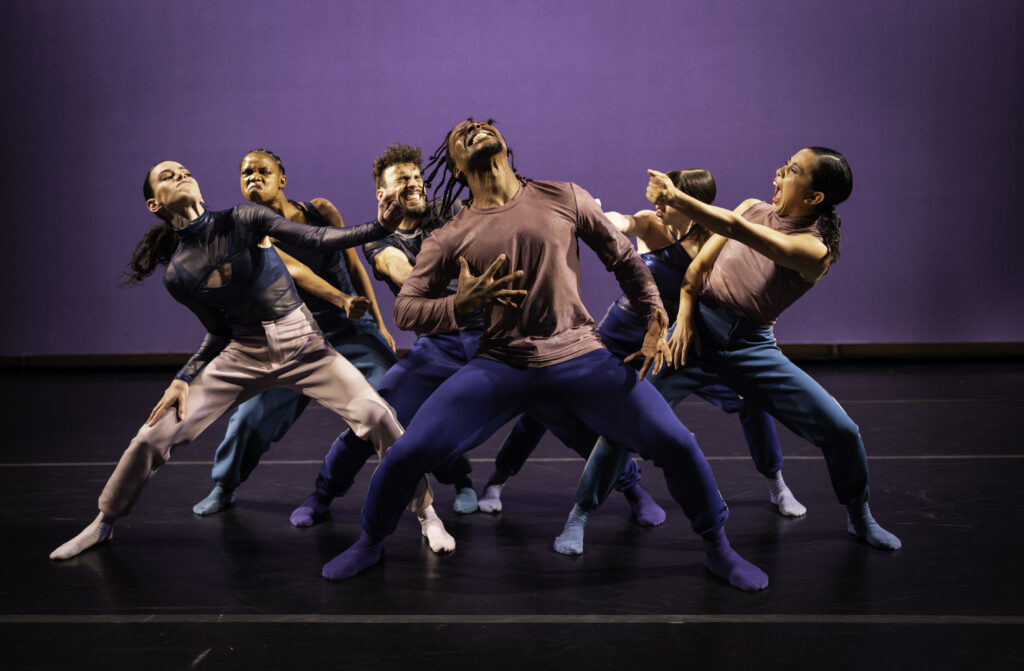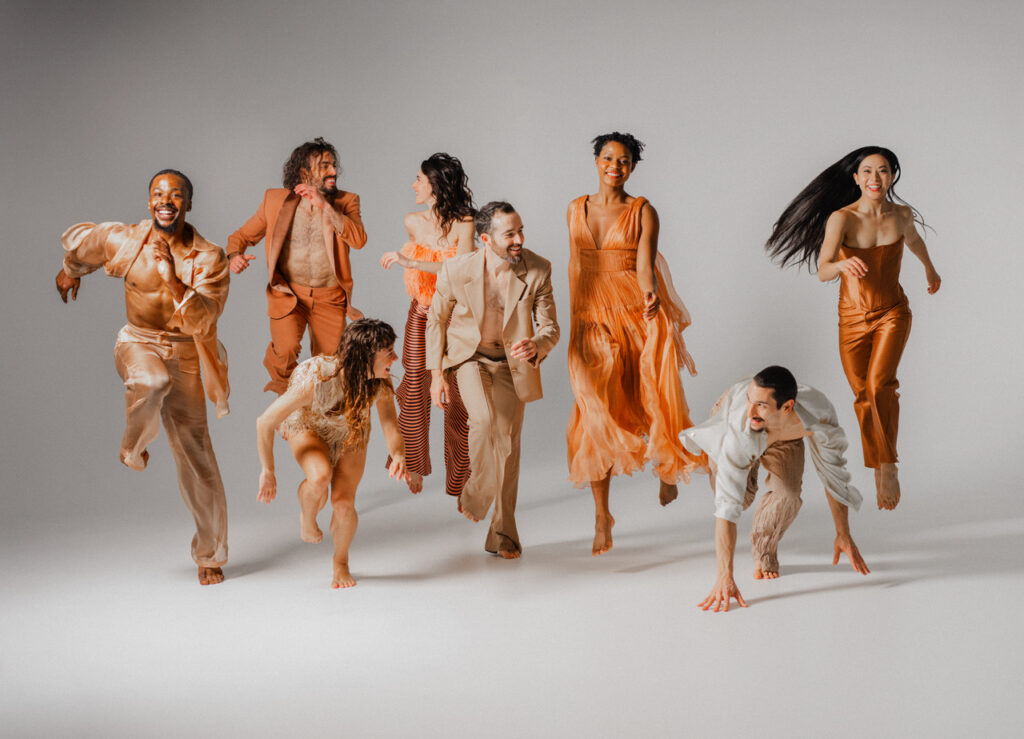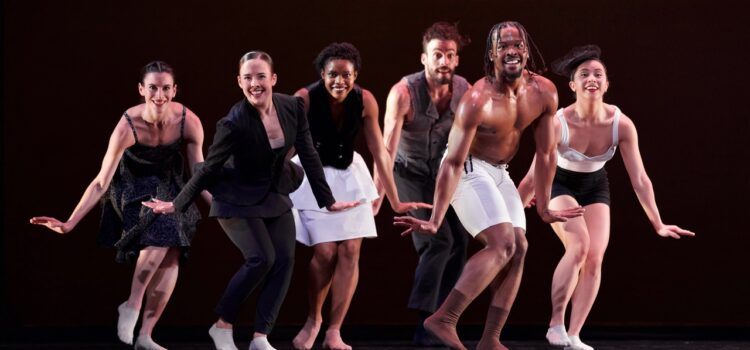By CB Adams
The American music journalist, essayist and critic Robert Christgau astutely noted that “When bodies move in relation to a designed space, be it stage or ballroom or living room or gymnasium or agora or Congo Square, they comment on that space.”
I was reminded of Christgau’s words during the performance of Los Angeles dance company Bodytraffic, presented by Dance St. Louis at the Touhill Performing Arts Center on April 6.
The works of Bodytraffic, established in 2007 under the guidance of Artistic Director Tina Finkelman Berkett, comment through the universal language of movement on the space that is best defined as the head space, the psyche.
Bodytraffic’s mission is to make dance approachable, accessible and inclusive on both national and international scales. With an eclectic repertoire that celebrates a variety of choreographic voices, Bodytraffic provides a dynamic platform for established and emerging artists.
The company also embraces its role as a cultural ambassador, fostering connections and understanding between communities through dance diplomacy, where every moment is captivating thanks to the unwavering skill and charm of the cast. Dance St. Louis, our local dance ambassador, should be commended for inviting Bodytraffic to St. Louis.
From Bodytraffic’s significant involvement in programs like DanceMotion USA in Israel and Jordan during the Obama administration to subsequent ambassadorial engagements in countries like South Korea, Algeria and Indonesia, the company exemplifies a commitment to cross-cultural exchange and artistic excellence.

Bodytraffic also engages in comprehensive education and outreach initiatives, Bodytraffic is dedicated to nurturing the next generation of dancers, empowering hundreds of students each year and fostering a culture of challenge, passion and growth. This is worth noting because it exemplifies the need for successful cultural organizations to engage with a variety of communities.
Bodytraffic presents dance as movement and as a catalyst for exploration, celebration and meaningful transformation, while displaying the profound power of rhythm to inspire and uplift. The Bodytraffic dance ensemble consists of Katie Garcia, Pedro Garcia, Alana Jones, Tiare Keeno, Ty Morrison, Joan Rodriguez, Guzman Rosado and Jordyn Santiago.
Bodytraffic is known for harnessing the vibrant energy of its Los Angeles roots to deliver compelling performances, and that essence was in full view during their performance at the Touhill as the dancers showcased impeccable technique and a fervent dedication to their craft with passion and precision. The four-part program evoked the spirit of a beloved television series (I’m thinking of PBS’s “American Experience”).
The performance began with a last-minute substitution of the program’s “A Million Voices” with “Blue Until June,” choreographed by Trey McIntyre. No reason for the substitution was given, but “Blue Until June” captivated as a mesmerizing dance piece that intertwined the soulful melodies of blues legend Etta James with fluid and emotive movements. McIntyre’s choreography, inspired by James’s rich vocals, created a poignant narrative of love’s complexities and the search for connection.

The music set the tone of personal and political turmoil as the dancers immersed themselves in a journey of longing and love. The piece unfolded with a solo woman, symbolizing vulnerability and strength, while other dancers gradually emerged from beneath a dark canvas tarp, their movements echoing the soulful rhythms of James’s songs.
Throughout the performance, dancers transitioned seamlessly between duets, displaying a range of lyrical and modern movements that conveyed passion and melancholy.
The dance reached its climax with James’s haunting rendition of “At Last,” as the lead female dancer found her perfect companion in a beautifully executed duet filled with lifts and extensions. McIntyre’s original vision, conceived for the Washington Ballet in 2000, proved it could still captivate with its blend of soul-stirring music and expressive choreography.
Next was Micaela Taylor’s “SNAP, “ a dance performed in an atmospheric haze that unfurled like a dynamic tapestry woven with threads of movement and sound. With the legendary James Brown’s pulsating rhythms as its heartbeat, the piece captured the sprawling diversity and pulsating energy of Los Angeles while seeming to urge the audience to “snap out” of “social pressures to conform and to celebrate what it means to find a home within yourself,” according to the program.

Taylor’s choreography, a testament to her own quest for identity amidst the vast urban landscape, transcended mere steps to become a resonant narrative of loneliness and resilience.
Against the backdrop of Brown’s anthem “This Is A Man’s World,” a lone male dancer emerged, his every movement a defiant assertion of self in the face of societal expectations. As the ensemble swirled around him, their bodies fluidly conducted the music’s raw power while the dancers ignited the stage with a frenetic energy.
“SNAP” fused street-style bravado and contemporary sensibility. Amid the exuberance, there were poignant contrasts provided by moments of quiet introspection as male and female dancers grappled with the constraints of gender norms. As the performance reached its denouement, its message resonated with a metaphorical exhortation to embrace individuality and snap out of the shadows into the light of self-discovery.
Bodytraffic made innovative use of the intermission by projecting what seemed like a video travelogue about Cuba. But the video really served as an introduction to Joan Rodriguez’s “Bloquea’o,” a poignant homage to resilience, love and the enduring quest for home amidst the backdrop of the 1962 Cuban Missile Crisis.
The piece featured the music of Cuban-Chinese cellist and interdisciplinary artist SUUVI (formerly known as Sophia Bacelar), who has been acclaimed for her expressive musicianship and disruptive, exploratory spirit.
Drawing from his own experience as a Cuban refugee, Rodriguez wove a narrative that intertwined personal struggle with collective upheaval, encapsulating the relentless pursuit of human dignity amid political turmoil. The evocative score, a rich tapestry of Cuban rhythms and historical echoes, served as both a soundtrack and a character in its own right, guiding the dancers through a symphony of emotions. Rodriguez’s choreography seamlessly melded Folklorico traditions with contemporary expressions that were augmented by the projected video.
“Bloquea’o” unfolded like a living tableau of love, loss and defiance. Against the backdrop of Suuvi’s haunting cello and Ricky Matute’s percussive cadence, the dancers traversed a landscape marked by longing and resilience.
John F. Kennedy’s voice echoed through the theater and mingled with the rhythms of Havana streets as the dance evoked the blurry boundaries between past and present and invited the audience to bear witness to the eternal struggle for freedom.
Talk about bodies moving in relation to a designed space!

Alejandro Cerrudo’s “PacoPepePluto,” a piece of playful innuendo and physical dexterity originally crafted for Hubbard Street Dance, concluded the program. “PacoPepePluto,” highlighted the talents of three male soloists: Joan Rodriguez, Pedro Garcia and Joseph Davis. Their performances exuded a blend of athleticism and whimsy.
Set against the backdrop of classic tunes by Joe Scalisi and Dean Martin, the dancers, adorned in nothing but nude dance belts, traversed the stage with a blend of coy charm and masculine strength reminiscent of Olympian gods in a mischievous mood. Matthew Miller’s deft backlighting skillfully highlighted the dancers’ musculature while delicately veiling their modesty when facing forward and underscored the choreography that was marked by bold leaps and agile turns.
“PacoPepePluto” cleverly explored the interplay between nudity, vulnerability and power while delivering a lighthearted-yet-compelling exploration of the human form. Each dancer, clad in the minimalist attire of dance belts, evoked a sense of both liberation and restraint while teasing with playful gestures that artfully obscured and revealed in equal measure.
Amidst the buoyant energy of the performance, Cerrudo strategically employed moments of shadow and silhouette, creating a visual tapestry that tantalized without veering into gratuitousness. The result was a piece that balanced the ethereal beauty of movement with a tongue-in-cheek nod to the inherent absurdity of the human condition.
With its blend of wit, athleticism and visual poetry, “PacoPepePluto” served as a fitting conclusion to an evening of captivating dance. Bodytraffic’s entire performance provided a deft exploration of preconceived notions of the body, leaving me with a lingering sense of wonderment and a newfound appreciation for the art of movement.
Dance St. Louis presented Bodytraffic at the Touhill Performing Arts Center on April 6


CB Adams is an award-winning fiction writer and photographer based in the Greater St. Louis area. A former music/arts editor and feature writer for the St. Louis Globe-Democrat, his non-fiction has been published in local, regional and national publications. His literary short stories have been published in more than a dozen literary journals and his fine art photography has been exhibited in more than 40 galley shows nationwide. Adams is the recipient of the Missouri Arts Council’s highest writing awards: the Writers’ Biennial and Missouri Writing!. The Riverfront Times named him, “St. Louis’ Most Under-Appreciated Writer” in 1996.

